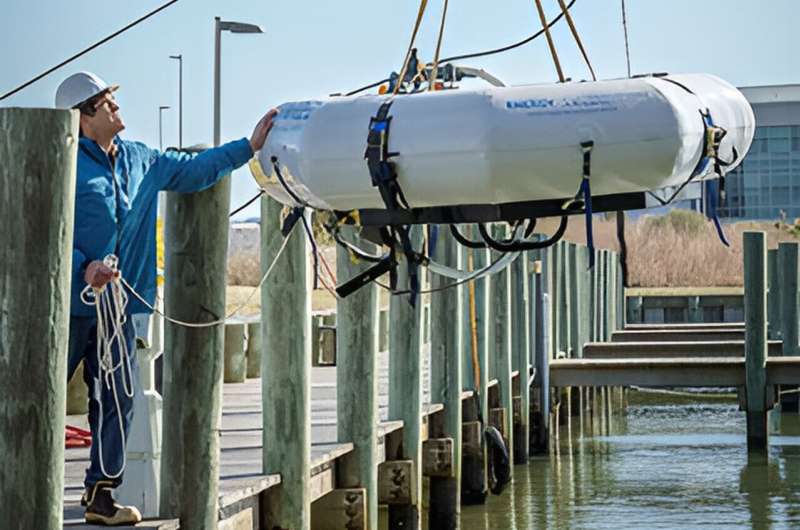
October 8, 2024 by Anya Breitenbach, National Renewable Energy Laboratory
Collected at: https://techxplore.com/news/2024-10-software-generate-maximum-electricity-tides.html
Marine energy devices have the potential to deliver gigantic amounts of power―if they can survive the ocean’s punishing conditions. Innovative system designs are needed to convert wave movements into electricity, but the sea is vast and complex, and deployment in these remote locations is expensive.
Created by the U.S. Department of Energy’s (DOE’s) National Renewable Energy Laboratory (NREL), Pacific Northwest National Laboratory (PNNL), and Sandia National Laboratories (Sandia), the Marine and Hydrokinetic Toolkit (MHKiT) can save time and money in the assessment of breakthrough technologies in marine renewable energy (MRE) and their performance under a wide range of aquatic conditions.
How can researchers and developers overcome obstacles and harness the full potential of MRE, a small fraction of which could provide enough electricity to power approximately 22 million U.S. homes?
Part of the solution lies with the measurement of waves and ocean currents, as well as power production, using real-world and modeled data. MHKiT supplies the data validation and standardized analysis tools needed to make informed decisions and maximize the potential clean power generated from this abundant supply.
Recent updates to the version of MHKiT built for the MATLAB programming platform (MHKiT-MATLAB), which is used extensively by industry engineers and university researchers, allow users to model extreme sea states and visualize theoretical river flow and turbulence.
Parallel updates to the version of MHKiT built for the Python programming platform (MHKiT-Python) include additional support for multidimensional data commonly generated by authorities such as the Coastal Data Information Program (CDIP) and the National Oceanic and Atmospheric Administration (NOAA).
“New functionality in MHKiT-MATLAB gives more developers the ability to standardize their measurement data, which not only can tell us the amount of energy and turbulence found at each site,” MHKiT-MATLAB Developer and NREL Data Scientist Andrew Simms said.
“It also lets us explore site conditions in more in-depth ways, hopefully leading to tidal turbines that can operate reliably for a long time into the future.”
Both versions of the toolkit provide code needed to maximize the potential of MRE systems. One set of features helps researchers model severe ocean conditions, such as unusually strong and large waves and swells. Other modules make it possible to analyze river and tidal flow data based on acoustic Doppler current profiler measurements.
The software helps researchers analyze how new technologies stack up against power performance, power quality, mechanical load, and resource specifications of the International Electrotechnical Commission, as well as the demands of specific marine sites and conditions.
MHKiT’s reproducible code examples guide users at every stage, from raw measurements to standardized analysis. The free, open-source suite of software gives users full access to MHKiT tools, allowing developers to process their data in a standardized way while gaining a comprehensive understanding of each step of analysis and contributing feedback along the way.
Going with the flow of two major programming platforms
With recent updates to the toolkit, the large number of researchers, designers, and developers who work in MATLAB-based environments can now use MHKiT to support more areas of their MRE modeling and analysis efforts, as well as contribute to ongoing tool refinement. New MHKiT-MATLAB (v0.5.0) features provide support for modeling extreme ocean conditions and generating river turbine visualizations with Delft3D modeling.
More extensive enhancements and additions to MHKiT-Python (v0.8.2) offer improved identification and analysis of significant wave events, including crests and crossings, as well as calculations of individual wave heights.
The Doppler Oceanography Library for pYthoN (DOLfYN) module adds altimeter support, better handling of data collected on the Nortek software that is standard for CDIP and NOAA, and more robust support for raw data interface (RDI) files. Other updates augment the processing and analysis of dimensional data (NetCDF) while streamlining the overall Python-based development process.
Lifting performance with a rising tide of collaboration
“Yes, MHKiT is a powerful tool, with standardized, validated code, software, and data that make it possible to control analysis quality,” NREL MHKiT-MATLAB Developer Chris Ivanov said. “But its real strengths lie in ongoing contributions of the collaborative community. Partners across the country and around the world help identify areas for future functionality and put modules through their paces in exploring new scenarios and ever-evolving system designs.”
Since the launch of MHKiT in 2020, the toolkit has been downloaded more than 29,000 times, with more than 30 collaborators contributing features and documentation to shape its functionality. Recently, this extended team has focused on unit testing, continuous integration, and code reviews to keep the software up to date while maintaining its effectiveness and reliability.
Unit testing ensures that each component of the toolkit functions correctly, while continuous integration automatically evaluates and integrates changes. Regular code reviews help identify and address issues, improving overall code quality.
Scanning the horizon for the next wave
MHKiT data and software tools are supplemented with clear and comprehensive examples of how to perform many different analysis tasks. In future Python and MATLAB versions, MHKiT developers plan to expand and improve these example notebooks, as well as build modules for acoustic monitoring and continue to refine overall functionality and performance.
“Before, most MRE developers were forced to build their own tools for data processing and analysis,” Simms said. “Now, MHKiT gives everyone a head start on data analysis. If we can make analysis as easy and painless as possible, developers can spend more of their time building better devices.”

Leave a Reply